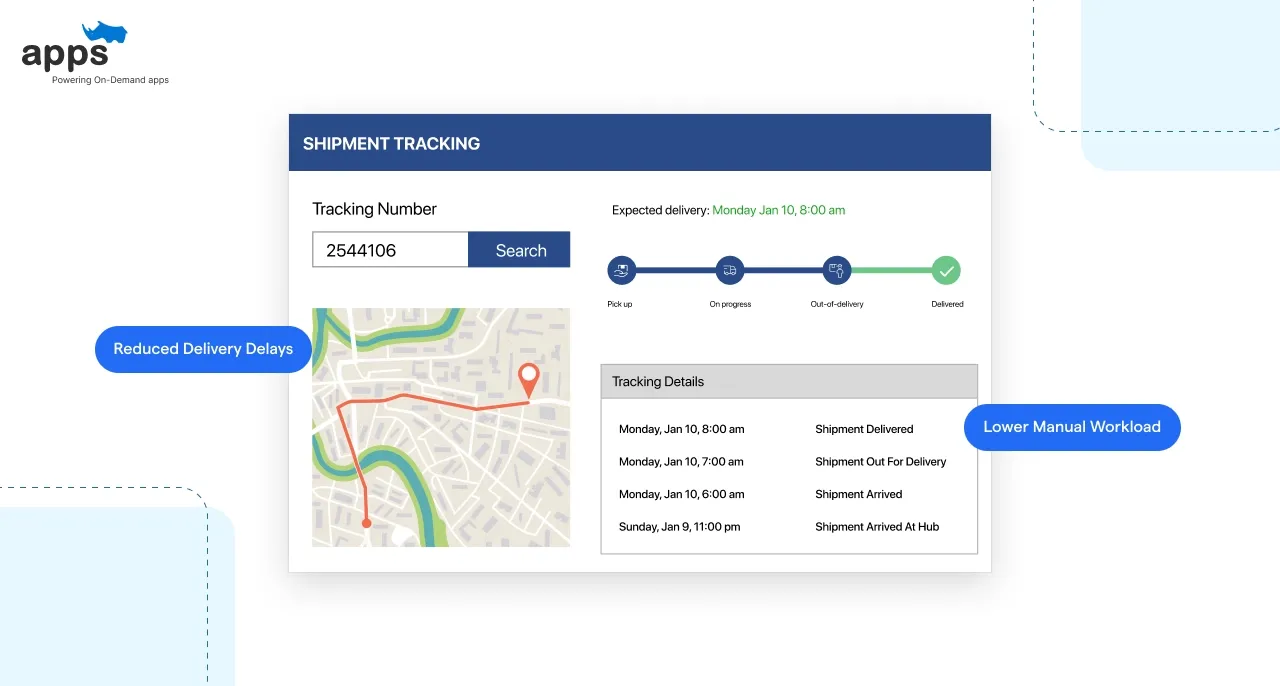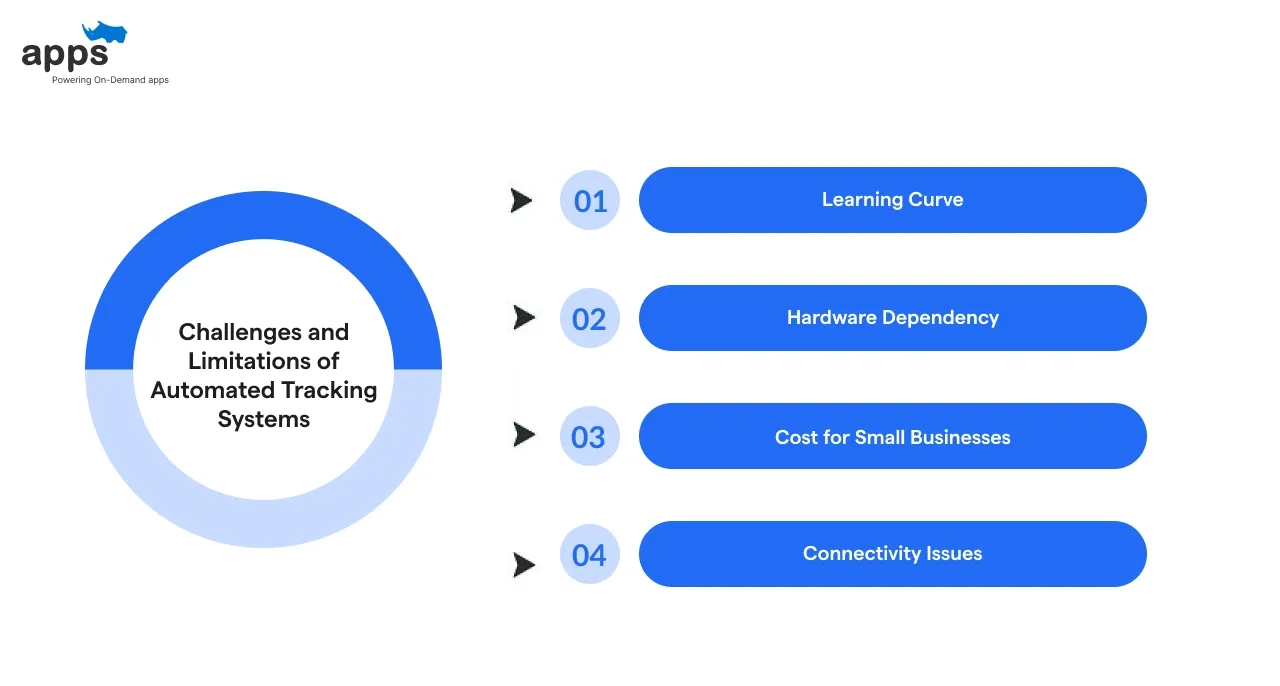- What is an Automated Shipment Tracking System?
- Automated shipment tracking system benefits
- How to Choose the Right Tool
- Case Study: SCM System
- Future Trends in Automated Shipment Tracking
- Final Thoughts on Embracing the Automate Tracking System
- Frequently Asked Questions (FAQs)
Table of Contents
21 Automated Shipment Tracking System Benefits you Need to Know
In today’s competitive logistics environment, customer expectations are soaring, and the margin for error is razor thin.
Delayed deliveries, lost packages, and poor communication can harm your brand’s reputation and profitability.
That’s where automated shipment tracking systems come into play.
These systems reduce manual effort and provide unmatched visibility by streamlining the entire shipping process, from dispatch to delivery.
Whether you run a small eCommerce business or manage enterprise-level supply chains, automated shipment tracking systems are no longer optional — they’re essential.
In this blog, you’ll discover 21 real-world benefits of using an automated shipment tracking system. Each benefit offers insight into how automation can improve your operations, enhance customer satisfaction, and give you a competitive edge in today’s evolving logistics landscape.
What is an Automated Shipment Tracking System?
An automated shipment tracking system is a digital tool that enables businesses to monitor the real-time status of their shipments across various carriers.
It consolidates data from FedEx, UPS, DHL, and others into a single interface and eliminates the need for manual tracking via emails or phone calls.
These systems rely on advanced technologies such as GPS tracking, barcode scanning, RFID, and cloud-based dashboards for continuous updates. Using APIs, GPS data, and carrier integrations, it provides timely updates, alerts, and actionable insights.
Some platforms even automate customer notifications, compliance logs, and returns, making them a powerful part of the modern supply chain.
Businesses can access these systems via web portals or mobile apps, providing flexibility and control even on the go. This kind of automation saves time and dramatically reduces the risk of human error.

Why It Matters in Today’s Supply Chain
Modern supply chains are more global, interconnected, and customer-centric than ever before. With increased competition and rising customer expectations, even a single delivery delay can cost a business valuable trust and recurring revenue.
Supply chain disruptions—whether caused by weather, geopolitical events, or internal mismanagement—can lead to significant financial losses. An automated shipment tracking system reduces this risk by offering live insights and improving transparency across the delivery lifecycle.
Moreover, businesses need systems that can scale as they grow. Manual tracking is simply unsustainable in a high-volume environment. Automation ensures that no matter how many shipments you’re handling, each gets the attention it deserves.
Automated shipment tracking system benefits

Automated shipment tracking systems revolutionize logistics by providing real-time visibility and minimizing manual effort.
These systems enhance operational efficiency, improve customer satisfaction, and reduce delivery-related errors through streamlined, data-driven processes.
1. Real-Time Shipment Visibility
Customers and teams benefit from knowing where every shipment is at all times.
Automated tracking systems pull data from multiple sources, ensuring you always have real-time location insights. This means less guesswork and more control.
According to Project44, 83% of consumers expect shipping updates, and 98% say delivery impacts brand loyalty.
2. Fewer Customer Complaints
When customers can self-track their orders, they call less. This reduces pressure on your support teams and improves the customer experience.
Automated emails and SMS notifications further reduce anxiety around delivery timelines.
Automated tracking helps reduce support tickets by speeding up updates and resolutions. (Source: arXiv)
3. Faster Issue Detection
You’ll know about a delay or misroute with proactive alerts before the customer does.
This gives you time to respond and resolve it efficiently. Automated flags highlight patterns of risk or delays, helping avoid recurring issues.
Route optimization tools integrated into tracking platforms help detect disruptions, traffic delays, and weather issues to ensure timely rerouting and minimal delivery impact.
4. Lower Manual Workload
Automation removes the need for repetitive manual tracking tasks. Your teams no longer waste hours checking shipment statuses.
This allows businesses to allocate those resources to more strategic tasks.
Automating logistics improves efficiency, reduces errors, and frees up significant time for teams to focus on strategic tasks.
5. Accurate Delivery Estimates
Algorithms predict delivery windows using past performance, weather, and current data, leading to more reliable delivery timelines. This sets proper customer expectations and increases satisfaction.
Providing accurate delivery estimates significantly boosts customer satisfaction and loyalty, which directly impacts Net Promoter Scores.
6. Better Planning for Warehouses
Knowing when shipments arrive helps teams plan unloading, storage, and labor schedules in advance. When inventory managers are informed, they reduce overstocking and understocking issues.
Benefits include reducing warehouse congestion and idle time by enabling better scheduling, faster turnarounds, and streamlined inbound-outbound coordination through real-time shipment visibility.
7. Reduced Delivery Delays
Automation alerts stakeholders about delays, enabling quicker rerouting or escalation. This minimizes actual downtime. Intelligent systems even suggest alternate delivery routes to avoid problem areas.
Companies using SAP’s Business Network have seen up to a 27% acceleration in product and order deliveries through automation. (Source: SupplyChainDigital)
8. Improved Customer Trust
Transparency builds trust. Customers feel in control when they can see exactly where their package is, reducing anxiety. Proactive updates establish your brand as honest and reliable.
81% of consumers say receiving proactive order updates influences their decision to purchase again. (Source: Narvar)
9. Time Savings for Teams
Less time spent chasing updates means more time focusing on high-priority work. This improves internal productivity. Logistics managers can use this time to refine strategy and vendor relationships.
Businesses using AfterShip have seen up to a 75% drop in “Where Is My Order?” inquiries, easing internal communication loads.
10. Fewer Lost Packages
Automated alerts highlight stalled or lost shipments immediately, increasing the chances of recovery before it’s too late. These systems track the last scan location and flag missing links.
Benefits include reducing write-offs and compensation by minimizing shipment loss, delays, and miscommunication through enhanced tracking accuracy and real-time incident alerts.
11. Stronger Brand Image
Professionalism reflects in your operations. Automated shipment tracking presents your business as tech-savvy and dependable. It signals to customers that you invest in quality.
Enhances perceived value and customer retention by delivering consistent experiences, transparent updates, and proactive service that strengthen brand trust and long-term loyalty.
12. Better Inventory Management
Tracking syncs with inventory systems to ensure accurate stock levels and avoid over-ordering or under-stocking. Real-time updates allow seamless restocking.
Helps align procurement, warehousing, and sales by creating real-time visibility, reducing stockouts, and improving coordination across the entire supply chain.
13. Data-Driven Decision Making
Tracking systems generate logistics data that helps you evaluate carrier performance, routes, etc. Managers can make better decisions based on complex numbers.
Data helps cut costs and optimize delivery efficiency by enabling route planning, fuel savings, and resource allocation based on real-time performance analytics.
14. Simplified Returns
With tracking-enabled returns, customers and teams can manage the process with less confusion and fewer errors. Businesses can also analyze return routes for efficiency.
Retailers improving their returns process are seeing stronger customer loyalty and higher satisfaction. (Source: Forrester)
15. Multi-Carrier Management
Instead of switching between portals, FedEx, DHL, UPS, and local carriers can be managed in one place. Automated systems normalize tracking codes and streamline dashboards.
Saves time and ensures consistency in reporting by automating data collection, reducing manual errors, and delivering real-time insights for more intelligent decision-making.
16. 24/7 Access to Tracking
Online dashboards and mobile apps provide real-time visibility outside office hours, supporting global operations. This allows businesses to stay connected anytime.
Enhances service quality across time zones, enabling global consistency, faster issue resolution, and improved customer experience regardless of location or operating hours.
17. Increased Delivery Speed
By automating dispatch, routing, and confirmation steps, businesses shorten the time from order to delivery. This enables faster fulfilment and improved service-level agreements.
LogiNext clients have achieved up to a 35% reduction in delivery times using automated driver assignment and routing solutions.
18. Boosted Customer Experience
Customers appreciate transparency and control. Shipment tracking improves the post-purchase journey. They’re more likely to buy again when they feel informed.
Reduced anxiety leads to better reviews and referrals, as proactive updates help build trust, satisfaction, and long-term customer loyalty.
19. Compliance and Documentation
Automated systems log shipping events, delivery confirmations, and timelines, making audits and regulatory checks easier. This ensures records are always up to date.
Real-time tracking is critical for healthcare, food, and export logistics, where timing, compliance, and condition-sensitive delivery are non-negotiable for safety and efficiency.
20. Cost Reduction Over Time
Automation leads to lower manual labor, reduced errors, faster deliveries, and fewer returns — all driving cost savings. Over time, this compounds into significant margins.
Thanks to innovations like AI-driven logistics, companies with advanced supply chain capabilities see up to 23% higher profitability. (Source: Accenture)
21. Competitive Edge
In crowded markets, real-time delivery transparency gives you an edge. It’s no longer a luxury; it’s a necessity. Brands that automate build loyalty faster.
Brands like Amazon use real-time tracking and updates as a core value proposition to boost trust, transparency, and customer satisfaction.
How to Choose the Right Tool
Choosing the right inventory tracking tool isn't just about features — it's about fit. Your business's structure, growth plans, and daily operations should guide the decision.
- Business Size and Industry: Startups, warehouses, restaurants, or enterprise retailers all have different needs. Pick a tool tailored to your scale and niche.
- Budget and Pricing Model: SaaS tools have monthly fees; on-premise tools may have high upfront costs. Balance short-term affordability and long-term ROI.
- Integration Needs: Ensure the software seamlessly connects with your POS, accounting, CRM, shipping systems, and any other operational tools you rely on daily.
- Ease of Use: Opt for user-friendly interfaces with intuitive design and mobile access to improve adoption rates across teams with varying tech comfort levels.
- Scalability: Choose a flexible platform that grows with your inventory volume, business complexity, team size, and expansion into new markets or locations.

Challenges and Limitations of Automated Tracking Systems

Automated tracking systems offer speed and accuracy but are not without hurdles. Understanding these limitations helps ensure smoother implementation and realistic expectations from the start.
- Learning Curve: Staff require dedicated training sessions to adapt to new workflows, interfaces, and operational processes introduced by automated tracking systems.
- Hardware Dependency: Devices like barcode scanners, RFID readers, and tablets may be necessary, adding upfront costs and requiring ongoing maintenance or upgrades.
- Cost for Small Businesses: Monthly subscriptions, setup fees, and hardware costs can burden micro-businesses or startups with limited budgets.
- Connectivity Issues: Cloud-based tools rely heavily on consistent internet access, and disruptions in connectivity can stall operations or delay real-time updates.
Case Study: SCM System
Problem: One of Sweden’s leading shipping providers faced challenges in shipment visibility and operational bottlenecks. The company transformed its logistics operations through a centralized supply chain management (SCM) platform.
Solution: The new SCM system integrates with various services, including mapping, analytics, aviation logistics, and route optimization, to offer end-to-end visibility and automated route and shipment management. This allowed real-time tracking of shipment status, including distance, weight, in-transit updates, and estimated time of arrival.
Results
- 54% Faster Shipment Processing — While exact shipment-speed gains vary by provider, automation platforms like Automation Anywhere report similarly significant improvements in processing time.
- 95% On-time Delivery Rate Achieved — According to delivery performance benchmarks, an on-time delivery rate of 95% or higher is considered excellent.
By consolidating logistics, tracking, and analytics into a unified SCM system, the company streamlined operations, improved delivery accuracy, and gained the operational leverage needed to scale efficiently across international markets.
Future Trends in Automated Shipment Tracking

The future of shipment tracking is bright, connected, and proactive. Emerging technologies are reshaping how businesses manage logistics, prevent issues, and enhance transparency across the supply chain.
1. AI-Powered Predictive Tracking
AI models are trained to predict delivery delays based on weather patterns, traffic data, and carrier history. This helps businesses proactively update customers before issues arise.
2. IoT-Based Package Monitoring
Smart sensors will soon monitor real-time shipment conditions like temperature, shock, and humidity. Over 600 million IoT devices will be in supply chains by 2027. (Source: Statista)
3. Blockchain for Tamper-Proof Logs
Blockchain will enable immutable shipment logs that enhance traceability, making it easier to detect fraud, validate delivery conditions, and ensure compliance in regulated industries.
Final Thoughts on Embracing the Automate Tracking System
Real-time inventory tracking software revolutionizes how businesses manage stock, reducing inefficiencies and improving decision-making. From livestock updates to predictive analytics, the benefits are substantial.
In today’s fast-paced market, businesses can’t afford to operate in the dark. Adopting the right tracking tool is no longer optional—it’s essential. Evaluate your needs, explore available solutions, and move toward more brilliant inventory control.
You can explore custom solutions if none of the off-the-shelf options are a perfect fit.
AppsRhino builds tailored shipment tracking platforms that integrate with your existing stack and meet unique business goals. Whether you need carrier API integration, mobile tracking dashboards, or compliance-ready logs, AppsRhino has the expertise to make it happen.
Frequently Asked Questions (FAQs)
What are real-time inventory tracking software solutions?
Real-time inventory tracking software provides live visibility of your stock across locations using automated updates through scanners, sensors, and apps.
How does real-time inventory tracking software improve operations?
It reduces human error, prevents stockouts, accelerates decision-making, and aligns inventory with real-time demand.
Which is the best real-time inventory tracking software for eCommerce?
Zoho Inventory, Cin7, and Ordoro are excellent for eCommerce due to multichannel syncing and shipping integration.
Is cloud-based inventory software better than on-premise tools?
Cloud-based tools offer flexibility, automatic updates, and remote access, while on-premise systems provide better control.
Can real-time tracking integrate with POS systems?
Yes, most modern systems offer POS integration to update stock once a sale is made.
Table of Contents
- What is an Automated Shipment Tracking System?
- Automated shipment tracking system benefits
- How to Choose the Right Tool
- Case Study: SCM System
- Future Trends in Automated Shipment Tracking
- Final Thoughts on Embracing the Automate Tracking System
- Frequently Asked Questions (FAQs)




